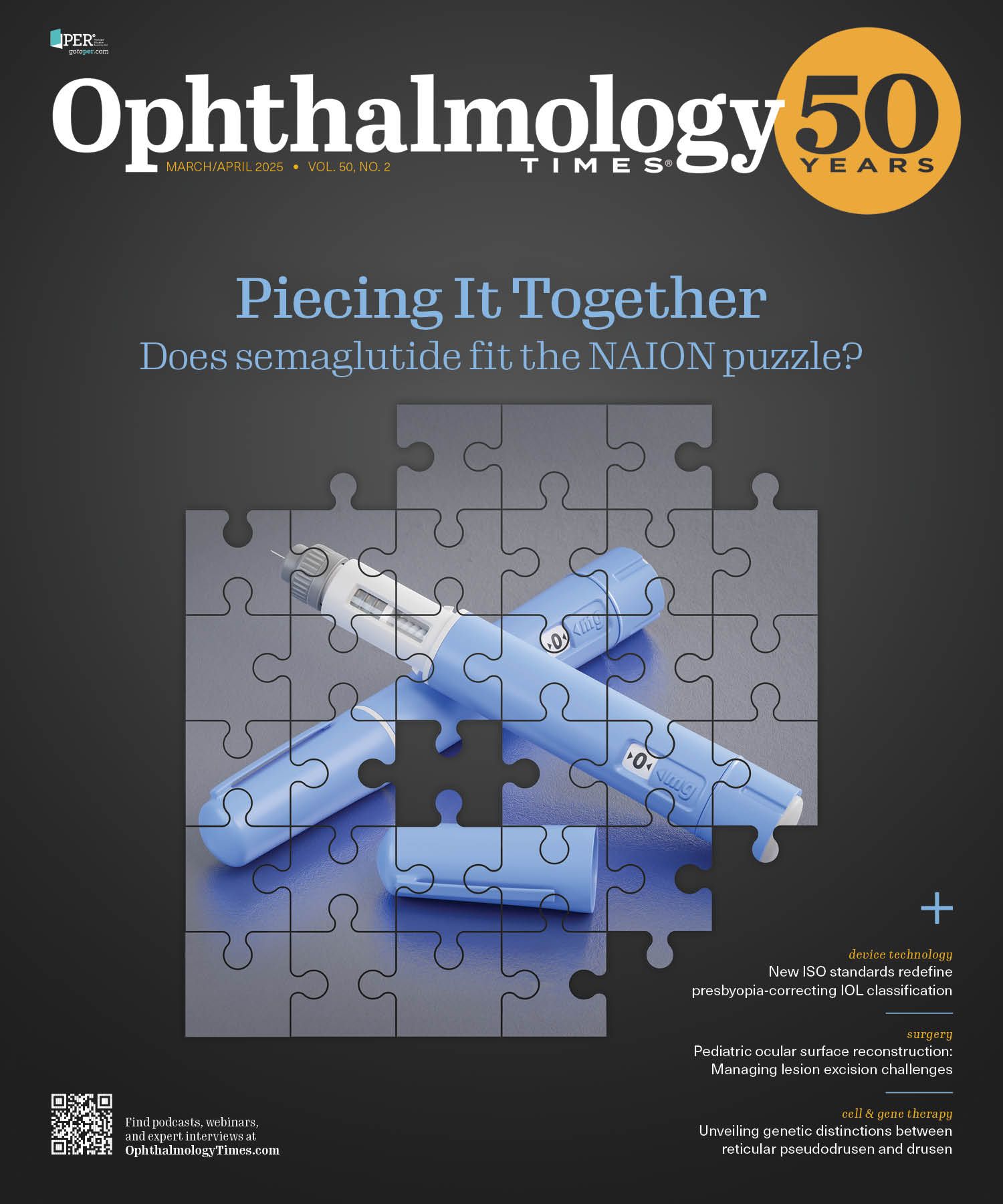Publication
Article
Digital Edition
Presbyopia treatment success begins with patient-centered care
Key Takeaways
- Pilocarpine 1.25% drops significantly improve distance-corrected near visual acuity, with clinical trials showing superior results compared with placebo.
- Surgical options for presbyopia include Kamra corneal inlays and multifocal IOLs, which improve visual acuity but may cause decreased contrast sensitivity and visual phenomena.
Personalizing treatment options and setting realistic expectations are crucial.
Clinicians must carefully guide patients with presbyopia in selecting the most appropriate treatment—whether eye drops, surgery, or IOL options—based on individual needs and expectations to achieve optimal outcomes. (Image credit: AdobeStock/rh2010)

With a range of treatments available for presbyopia, the challenge for clinicians is to guide patients toward the most appropriate choice. Yassine Daoud, MD, FACS, explored some of these options at the Johns Hopkins Wilmer Eye Institute’s 37th Annual Current Concepts in Ophthalmology meeting1 in Baltimore, Maryland.
Daoud, an associate professor of ophthalmology and chair of ophthalmology at Johns Hopkins Howard County Medical Center in Baltimore, shared his insights on this complex decision-making process. Although the list of treatment options is not exhaustive, Daoud specifically discussed presbyopia-correcting eye drops, presbyopia surgery, and IOL approaches.
Presbyopia-correcting eye drops
Pilocarpine 1.25% drops (Vuity; AbbVie) were evaluated in the GEMINI 1 (NCT03804268) and GEMINI 2 (NCT03857542) randomized, double-masked, phase 3 clinical studies in 750 patients aged 40 to 55 years.2 The results showed that about 90% of patients had a distance-corrected near visual acuity (DCNVA) exceeding 20/40 mesopic, Daoud recounted.
The GEMINI 1 results showed that 31% gained over 3 lines of DCNVA compared with 8% with placebo, and the GEMINI 2 results showed that 26% did so compared with 11% with placebo, he noted.
Presbyopia surgery
These procedures include IntraCor (Technolas Perfect Vision), PresbyLASIK, monovision LASIK, photorefractive keratectomy, and Kamra corneal inlays (AcuFocus). The Kamra corneal inlay uses the pinhole effect to change vision and increase the depth of focus. Another product, the Raindrop Near Vision Inlay (ReVision Optics) was removed from the market because of haze in 75% of patients, he noted.
Multifocal IOLs
Daoud cited data from a study that assessed multifocal and accommodating IOLs used to treat presbyopia.3 The results indicated that the presbyopia-correcting lenses improved the uncorrected distance VA and decreased spectacle dependence after cataract surgery. The mesopic contrast sensitivity decreased compared with monofocal IOLs, and patient-reported visual phenomena are more likely to occur in patients with multifocal or extended depth of focus (EDOF) IOLs implanted.
Three multifocal and EDOF IOLs are available in the US: AcrySof IQ Vivity and AcrySof IQ PanOptix (Alcon) and Tecnis Symfony/Tecnis Symfony Toric (Johnson & Johnson Surgical Vision). The respective reported rates of spectacle independence are 21.6%, 80.5%, and 85%; low rates of severe glare, halos, and starbursts have been reported with these lenses.
Light-adjustable lens (RxSight)
This technology uses a light adjustment beam to adjust the refractive power of the lenses. The light adjustments are scheduled about 2 weeks after implantation. Following up to 3 adjustments, the IOL power is locked in. Daoud reported that 9 of 10 patients with the light-adjustable lens achieved 20/20 J2 vision and 8 of 10 achieved 20/20 J1 vision without glare or halos. However, Daoud also reported that he has treated the rare patient with 20/20 vision who presented to him “unhappy” and described glare, halos, poor focus, and poor-quality vision.
IC-8 Apthera IOL (Bausch + Lomb)
This IOL, approved by the FDA in July 2022, was the first of its kind that combined small-aperture optics and EDOF. The IOL is indicated for unilateral implantation in the nondominant eye of patients over age 22 who have less than 1.5 D of astigmatism. The targeted refraction is –0.75 D. The candidates for implantation also must have no history of retinal disease, no predisposition to a future retinal disease, and pupillary dilation less than 7 mm.
The advisories associated with the lens are decreased contrast sensitivity with bilateral implantation, and severe glare, halo, starburst, and hazy vision can occur.4 If retinal surgery is needed after implantation, the IOL may require explantation. In addition, YAG laser is more difficult in the presence of this IOL, and diagnostic testing may take longer.
The clinical results of an investigational drug exemption clinical study3 showed that the Apthera IC-8 achieved comparable binocular distance and superior intermediate and near vision in patients with bilateral monofocal IOLs.
Daoud advised clinicians to be alert to central K opacity, dimming of light, and bilateral implantation and the status of the visual fields. Patient selection is the primary concern associated with this IOL because it can be associated with slower visual recovery compared with other options. Patients who opt for this lens must be encouraged to exercise patience. He pointed out that 1 week after implantation, vision can still be blurry.
Daoud advised that precise information about the cornea be gathered using all available technology. Consideration of this IOL also calls for a detailed discussion with the patients about their expectations for vision postoperatively.
“Selection, selection, selection is of paramount importance,” Daoud said. “Know the limits of the technology. Lower expectations for the patient, and if the outcome is better, you overdelivered.”
Presurgical expectations can turn into postsurgical complications, he concluded.
Yassine Daoud, MD, FACS
E: ydaoud1@jh.edu
Daoud is an associate professor of ophthalmology and chair of ophthalmology at Johns Hopkins Howard County Medical Center in Baltimore, Maryland. He has no financial interest in this subject matter.
References
Daoud Y. Approach to presbyopia: optical, drops, surgery. Presented at: Johns Hopkins Wilmer Eye Institute’s 37th Annual Current Concepts in Ophthalmology; December 5-6, 2024; Baltimore, MD.
Vuity. Prescribing information. AbbVie Inc; 2023. Accessed March 3, 2025. https://www.rxabbvie.com/pdf/vuity_pi.pdf
Schallhorn JM, Pantanelli SM, Lin CC, et al. Multifocal and accommodating intraocular lenses for the treatment of presbyopia: a report by the American Academy of Ophthalmology. Ophthalmology. 2021;128(10):1469-1482. doi:10.1016/j.ophtha.2021.03.013
Summary of safety and effectiveness data (SSED): IC-8 Apthera IOL. FDA. July 22, 2022. Accessed March 14, 2025. https://www.accessdata.fda.gov/cdrh_docs/pdf21/P210005B.pdf
Newsletter
Don’t miss out—get Ophthalmology Times updates on the latest clinical advancements and expert interviews, straight to your inbox.





